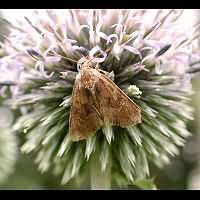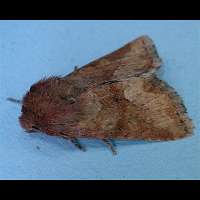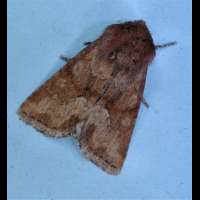Middle-barred Minor Oligia fasciuncula
In Britain no less than six species of Minors do fly about. All are widespread and quite common. The sad thing is, that all Minors are very variable and some species are even extremely varying. The Middle-barred Minor usually is among the more easy to identify. The basic coulour is yellowish, reddish or pinkish brown. Most other Minors are greyish brown. Unfortunately one variation of the Middle-barred Minor is greyish brown as well... The best way of identifying it is by looking at the bar after which the species is named. The bar is in the middle of the wing indeed and above it and below it are usually light patches. Of the other Minors the Cloaked Minor sometimes is very similar to the Middle-barred Minor, but it always has a (faint) thin line running across at the middle of the wing. The two species are however rarely seen together, for the Middle-barred Minor stops flying when the Cloaked Minor appears. Experts tell the two species apart by looking at their shape. The Cloaked Minor is more slender. The Middle-bar Minor regularly flies by day and even feeds by day. The Cloaked Minor flies before dusk, especially the males, but is never seen feeding during daytime. Reaching a wingspan of some 22 to 26mm the Middle-barred Minor is a very small Owlet Moth indeed.
The eggs are being laid in summer. In August the first caterpillars appear. They hide in the foodplant by day and feed during the night only. The half-grown larva overwinters. From April onwards the larvae are fullgrown. They hide between debris and spin a cocoon just above the ground to pupate in. Pupation takes about a month. The caterpillar of the Middle-barred Minor is white ochreous with a number of thin light brown lines running all over the body. The dorsal line is white and rather broad. The larva is speckled with small black dots. The head is of the same colour as the body with markings in the color of the body lines. The caterpillar reaches a length of 19 to 23mm. The foodplants are a number of grasses, but Tufted Hair-grass is favoured.
The Middle-barred Minor is on the wing for a short span of time. The first are seen by the end of May and usually by the end of June it is all over. However spare individuals are seen flying about until mid-August. It is not always sure these actually are Middle-barred Minors. Some Cloaked Minors are regularly mistaken for Middle-barred Minors. They frequently fly by day and are seen visiting flowers to feed. When eating the wings are kept like a triangle. This makes the moth very similar to Endotricha flammealis and some other daytime Pyralids. When feeding in daylight the moths can be approached easily and it is easy to take their picture. Animals caught during the night will remain motionless for a long time, but shouldn't be touched. The Middle-barred Minor is attracted to light and sugar in very small numbers only. This is a very common species in most of the continent, including all of Britain and Ireland.
In Britain no less than six species of Minors do fly about. All are widespread and quite common. The sad thing is, that all Minors are very variable and some species are even extremely varying. The Middle-barred Minor usually is among the more easy to identify. The basic coulour is yellowish, reddish or pinkish brown. Most other Minors are greyish brown. Unfortunately one variation of the Middle-barred Minor is greyish brown as well... The best way of identifying it is by looking at the bar after which the species is named. The bar is in the middle of the wing indeed and above it and below it are usually light patches. Of the other Minors the Cloaked Minor sometimes is very similar to the Middle-barred Minor, but it always has a (faint) thin line running across at the middle of the wing. The two species are however rarely seen together, for the Middle-barred Minor stops flying when the Cloaked Minor appears. Experts tell the two species apart by looking at their shape. The Cloaked Minor is more slender. The Middle-bar Minor regularly flies by day and even feeds by day. The Cloaked Minor flies before dusk, especially the males, but is never seen feeding during daytime. Reaching a wingspan of some 22 to 26mm the Middle-barred Minor is a very small Owlet Moth indeed.
The eggs are being laid in summer. In August the first caterpillars appear. They hide in the foodplant by day and feed during the night only. The half-grown larva overwinters. From April onwards the larvae are fullgrown. They hide between debris and spin a cocoon just above the ground to pupate in. Pupation takes about a month. The caterpillar of the Middle-barred Minor is white ochreous with a number of thin light brown lines running all over the body. The dorsal line is white and rather broad. The larva is speckled with small black dots. The head is of the same colour as the body with markings in the color of the body lines. The caterpillar reaches a length of 19 to 23mm. The foodplants are a number of grasses, but Tufted Hair-grass is favoured.
The Middle-barred Minor is on the wing for a short span of time. The first are seen by the end of May and usually by the end of June it is all over. However spare individuals are seen flying about until mid-August. It is not always sure these actually are Middle-barred Minors. Some Cloaked Minors are regularly mistaken for Middle-barred Minors. They frequently fly by day and are seen visiting flowers to feed. When eating the wings are kept like a triangle. This makes the moth very similar to Endotricha flammealis and some other daytime Pyralids. When feeding in daylight the moths can be approached easily and it is easy to take their picture. Animals caught during the night will remain motionless for a long time, but shouldn't be touched. The Middle-barred Minor is attracted to light and sugar in very small numbers only. This is a very common species in most of the continent, including all of Britain and Ireland.







